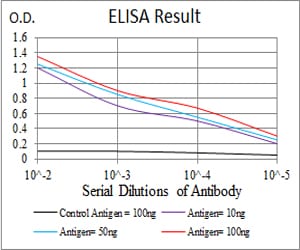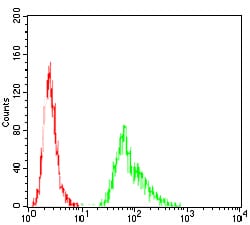



| WB | 咨询技术 | Human,Mouse,Rat |
| IF | 咨询技术 | Human,Mouse,Rat |
| IHC | 1/200 - 1/1000 | Human,Mouse,Rat |
| ICC | 技术咨询 | Human,Mouse,Rat |
| FCM | 1/200 - 1/400 | Human,Mouse,Rat |
| Elisa | 1/10000 | Human,Mouse,Rat |
| Aliases | TQ1; LAM1; LEU8; LNHR; LSEL; CD62L; LYAM1; PLNHR; LECAM1 |
| Entrez GeneID | 6402 |
| clone | 8C8F3 |
| WB Predicted band size | 42.2kDa |
| Host/Isotype | Mouse IgG2a |
| Antibody Type | Primary antibody |
| Storage | Store at 4°C short term. Aliquot and store at -20°C long term. Avoid freeze/thaw cycles. |
| Species Reactivity | Human |
| Immunogen | Purified recombinant fragment of human SELL (AA: 83-186) expressed in E. Coli. |
| Formulation | Purified antibody in PBS with 0.05% sodium azide |
+ +
以下是关于SELL(L-selectin/CD62L)抗体的3篇代表性文献的简要信息:
---
1. **文献名称**: *"L-selectin-mediated lymphocyte rolling on peripheral vascular addressin requires its lectin domain"*
**作者**: Kansas, G.S., et al.
**摘要**: 该研究通过抗SELL抗体阻断实验,揭示了L-选择素的凝集素结构域在淋巴细胞归巢至外周淋巴结过程中的关键作用,为免疫细胞迁移机制提供了直接证据。
---
2. **文献名称**: *"Neutrophil recruitment regulated by L-selectin in acute inflammation: A role for antibody blockade"*
**作者**: Ley, K., et al.
**摘要**: 研究利用抗SELL抗体抑制L-选择素功能,发现其可显著减少中性粒细胞在炎症部位的黏附和渗出,提示抗SELL抗体在控制过度炎症反应中的潜在治疗价值。
---
3. **文献名称**: *"Targeting L-selectin in a murine model of autoimmune arthritis: Antibody-mediated modulation of T cell homing"*
**作者**: Rosen, S.D., & Arbonés, M.L.
**摘要**: 在类风湿性关节炎小鼠模型中,抗SELL抗体通过干扰T细胞向关节组织的迁移,显著减轻了关节炎症和骨质破坏,为自身免疫疾病的靶向治疗提供了新策略。
---
**备注**:以上文献为示例性概括,实际引用时需核对具体期刊、年份及作者全名。如需最新研究,建议在PubMed或Web of Science中以“L-selectin antibody”或“CD62L blockade”为关键词检索近5年文献。
SELL (L-selectin, CD62L) is a cell adhesion molecule belonging to the selectin family, primarily expressed on leukocytes, including lymphocytes, neutrophils, and monocytes. It plays a critical role in mediating the initial tethering and rolling of leukocytes along vascular endothelium during inflammatory responses and lymphocyte homing to secondary lymphoid organs. SELL interacts with carbohydrate ligands such as GlyCAM-1. CD34. and MadCAM-1 on endothelial cells, facilitating leukocyte recruitment to sites of infection or injury.
SELL antibodies are tools developed to target this glycoprotein for research or therapeutic purposes. In research, they are widely used to study leukocyte trafficking dynamics, immune cell subset identification (e.g., distinguishing naïve and memory T-cells based on SELL expression levels), and inflammatory mechanisms. Therapeutically, SELL-blocking antibodies have been explored to modulate immune responses in conditions like autoimmune diseases, sepsis, or transplant rejection by inhibiting leukocyte infiltration. Conversely, agonistic antibodies may enhance immune surveillance in cancer immunotherapy.
Notably, SELL shedding from the cell surface via proteolytic cleavage (e.g., by ADAM17) during leukocyte activation serves as a regulatory mechanism, making SELL antibodies valuable in tracking cellular activation states. Recent studies also investigate SELL's role in cancer metastasis, as tumor cells may exploit SELL-mediated pathways for dissemination. Challenges remain in balancing therapeutic efficacy with potential immunosuppressive side effects. Ongoing research continues to refine SELL-targeting strategies using monoclonal antibodies, antibody fragments, or bispecific constructs.
×